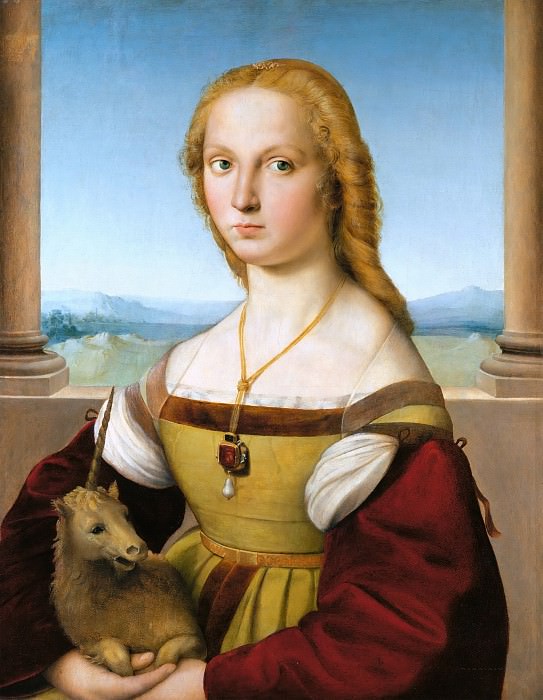Lady with a Unicorn Raphael (1483-1520)
Raphael – Lady with a Unicorn
Edit attribution
Download full size: 2793×3606 px (2,4 Mb)
Painter: Raphael
Location: Borghese gallery, Rome (Galleria Borghese).
The painting is painted in the typical Renaissance style. The painting depicts a girl holding a small unicorn. The unicorn has long been considered a symbol of purity. The legend says that only a virgin could tame the raging unicorn. Raphael Santi’s painting depicts a widely popular subject at the time. It was reflected in numerous works of Renaissance art. In the center of the canvas we see a young girl depicted waist-length.
Description of Raphael Santi’s The Lady with the Unicorn
The painting is painted in the typical Renaissance style. The painting depicts a girl holding a small unicorn. The unicorn has long been considered a symbol of purity. The legend says that only a virgin could tame the raging unicorn.
Raphael Santi’s painting depicts a widely popular subject at the time. It was reflected in numerous works of Renaissance art.
In the center of the canvas we see a young girl depicted waist-length. It is a typical portrait of the time. She is seated against a background of nature, visible from behind the columns of the castle. She is wearing a wide beautiful dress made of cloth of golden and burgundy colors. The dress has a wide and deep neckline, but according to the proportions of the Renaissance figure, the girl has excessively sloping shoulders and a completely flat chest.
On her neck she wears an unusual pendant consisting of a leather cord and a large burgundy stone, most likely a ruby.
The girl has light waxy skin, it is almost transparent. The girl’s hair is blond, neatly arranged in a hairstyle, but you can see the length of the hair. The hair is slightly curly. The blond hair is another symbol of purity.
The girl’s face is unbiased. It is impossible to guess a single emotion on the frozen face. At the same time she looks reproachfully at the spectator. Her lips are firmly pressed together-she is confidently in control of the situation. Her face is calm and without a shadow of doubt.
The unicorn in her hands is calm and content. Its mouth is half-open, its eyes looking to the right. The absence of a horn would make this mythical creature look like a unicorn.
In this painting, Raphael Santi celebrates the wonder of chastity, the beauty and purity of this state. During the Renaissance, virginity was considered a power that gave some special, magical properties to the woman. The girl, on the other hand, is content with her position, enjoying her power to command the unicorn.
Кому понравилось
Пожалуйста, подождите
На эту операцию может потребоваться несколько секунд.
Информация появится в новом окне,
если открытие новых окон не запрещено в настройках вашего браузера.
You need to login
Для работы с коллекциями – пожалуйста, войдите в аккаунт (open in new window).




















COMMENTS: 1 Ответы
Душа её доверчива, открыта,
Она созвучна с судьбами людей,
И чаша жизни вовсе не допита,
И с каждым годом облик всё милей!
You cannot comment Why?
The subtext of the painting is rich with symbolism commonly found in Renaissance art. The unicorn itself is a powerful symbol of purity, innocence, and chastity. In medieval and Renaissance lore, unicorns were said to be untamable except by a virgin. Therefore, the presence of the unicorn being held by the lady strongly suggests her virginity and virtuous nature. The womans calm and composed demeanor, combined with her direct gaze, further reinforces an image of dignity and self-possession. The landscape background, serene and somewhat idealized, contributes to an atmosphere of tranquility and perhaps spiritual contemplation. The overall composition suggests a portrait not just of a person, but of her character and moral standing within societal expectations of the time, emphasizing purity and elevated status.